Riverfront Stadium
Riverfront Stadium, also known as Cinergy Field from 1996 to 2002, was a multi-purpose stadium in Cincinnati, Ohio, United States that was the home of the Cincinnati Reds of Major League Baseball from 1970 through 2002 and the Cincinnati Bengals of the National Football League from 1970 to 1999. Located on the Ohio River in downtown Cincinnati, the stadium was best known as the home of "The Big Red Machine", as the Reds were often called in the 1970s.
"The Home of the Big Red Machine" "The Jungle" | |
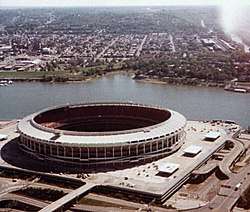 The Stadium seen from above in 1980 | |
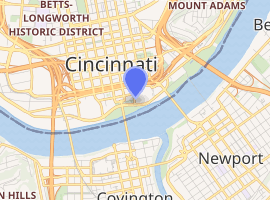
| |
| Former names | Riverfront Stadium (1970–96) Cinergy Field (1996–2002) |
|---|---|
| Location | 201 East Pete Rose Way, Cincinnati 45202 |
| Coordinates | 39°5′48″N 84°30′30″W |
| Owner | City of Cincinnati |
| Capacity | 52,952 (baseball, 1970–2000) 59,754 (football) 39,000 (baseball, 2001–02) |
| Field size | 1970–2000 Left field – 330 ft (100 m) Left-center field – 375 ft (114 m) Center field – 404 ft (123 m) Right-center field – 375 ft (114 m) Right field – 330 ft (100 m) Backstop – 51 ft (16 m) 2001–2002 Left field – 325 ft (99 m) Left-center field – 370 ft (110 m) Center field – 393 ft (120 m) Right-center field – 373 ft (114 m) Right field – 325 ft (99 m) Backstop – 41 ft (12 m) |
| Surface | AstroTurf 8 (1970–2000) Grass (2001–2002) |
| Construction | |
| Broke ground | February 1, 1968 |
| Opened | June 30, 1970 |
| Closed | September 22, 2002 |
| Demolished | December 29, 2002 |
| Construction cost | US$45 million ($296 million in 2019 dollars[1]) |
| Architect | Heery & Heery FABRAP |
| Structural engineer | Prybylowski and Gravino, Inc.[2] |
| General contractor | Huber, Hunt & Nichols[3] |
| Tenants | |
| Cincinnati Bengals (NFL) (1970–1999) Cincinnati Reds (MLB) (1970–2002) Cincinnati Bearcats (NCAA) (1990) | |
Construction began on February 1, 1968, and was completed at a cost of less than $50 million. On June 30, 1970, the Reds hosted the Atlanta Braves in their grand opening, with Hank Aaron hitting the first ever home run at Riverfront. Two weeks later on July 14, 1970, Riverfront hosted the 1970 Major League Baseball All-Star Game. This game is best remembered for the often-replayed collision at home plate between Reds star Pete Rose and catcher Ray Fosse of the Cleveland Indians.
In September 1996, Riverfront Stadium was renamed "Cinergy Field" in a sponsorship deal with Greater Cincinnati energy company Cinergy. In 2001, to make room for Great American Ball Park, the seating capacity at Cinergy Field was reduced to 39,000. There was a huge in-play wall in center field visible after the renovations, to serve as the batter's eye. The stadium was demolished by implosion on December 29, 2002.
History
Riverfront was a multi-purpose, circular "cookie-cutter" stadium, one of many built in the United States in the late 1960s and early 1970s as communities sought to save money by having their football and baseball teams share the same facility. Riverfront, Veterans Stadium in Philadelphia, Busch Memorial Stadium in St. Louis, Atlanta–Fulton County Stadium in Atlanta, Three Rivers Stadium in Pittsburgh, Shea Stadium in New York and Robert F. Kennedy Memorial Stadium in Washington, D.C. all opened within a few years of each other and were largely indistinguishable from one another; in particular, it was often confused with fellow Ohio River cookie-cutter Three Rivers Stadium by sportscasters because of the two stadium's similar names and similar designs.
One feature of Riverfront that distinguished it from other cookie-cutters was that the field level seats for baseball were divided in half directly behind home plate, with the third-base side stands wheeled to left field and the ones on the first-base side remaining stationary for conversion to a football seating configuration.[4] The astroturf panels covering the tracks could be seen in left field during Reds games. (Shea Stadium in New York had featured a similar movable field-level seats design from its debut in 1964 until the Jets moved to Giants Stadium in New Jersey in 1984, after which the Mets retrofitted Shea for exclusive baseball use.[5] A variation of this design was also used at Three Rivers Stadium in Pittsburgh.)[6]
The site Riverfront Stadium sat on originally included the 2nd Street tenement, birthplace and boyhood home of cowboy singer and actor Roy Rogers, who joked that he was born "somewhere between second base and center field."
Riverfront Stadium's scoreboard was designed by American Sign and Indicator, but in its last years was maintained by Trans-Lux. That scoreboard would be upgraded in the 1980s with the addition of an adjacent Sony JumboTron.
Big Red Machine
The Reds moved to Riverfront Stadium midway through the 1970 season, after spending over 86 years at the intersection of Findlay Street and Western Avenue – the last 57½ of those years at Crosley Field. Riverfront quickly earned a place in Cincinnati's century-long baseball tradition as the home of one of the best teams in baseball history. The Reds had only won three pennants in their final 39 years at Crosley Field (1939, 1940, 1961) but made the World Series in Riverfront's first year (1970) and a total of four times in the stadium's first seven years, with the Reds winning back-to-back championships in 1975 and 1976. The World Series would return in 1990, with Cincinnati winning the first two of a four-game sweep of the Oakland Athletics at Riverfront.

Baseball purists disliked Riverfront's artificial turf, but Reds' Manager Sparky Anderson and General Manager Bob Howsam took advantage of it by encouraging speed and line drive hitting that could produce doubles, triples and high-bouncing infield hits. Players who combined power and speed like Joe Morgan, Pete Rose and Ken Griffey, Sr. thrived there. On defense, the fast surface and virtually dirtless infield (see photo) rewarded range and quickness by both outfielders and infielders, like shortstop Dave Concepción who used the turf to bounce many of his long throws to first. Catcher Johnny Bench and first baseman Tony Pérez played here. The artificial turf covered not only the normal grass area of the ballpark but also most of the normally dirt-covered portion of the infield. Only the pitcher's mound, the home plate area (in two circled areas), and cutouts around first, second and third bases had dirt surfaces (which were covered in five-sided diamond shaped areas). This was the first stadium in the majors with this "sliding pit" configuration. The new stadiums that would follow (Veterans Stadium, Royals Stadium, Louisiana Superdome, Olympic Stadium (Montreal), Exhibition Stadium, Kingdome, Hubert H. Humphrey Metrodome, B.C. Place, SkyDome) installed sliding pits as the original layout, and the existing artificial turf fields in San Francisco, Houston, Pittsburgh, and St. Louis would change to the cut-out configuration within the next few years.
Riverfront hosted the MLB All-Star Game twice: first on July 14, 1970 with President Richard Nixon in attendance (51,838 total attendance), and again on July 12, 1988 (55,837 attendance).
Professional football
Despite Cincinnati's love of baseball, it was the prospect of a professional football team that finally moved the city to end 20 years of discussion and build a new stadium on the downtown riverfront. After playing for two seasons at Nippert Stadium on the University of Cincinnati campus, the Bengals built on the Reds' success in the stadium's first year when they recorded their first winning season and playoff appearance in 1970, just their third year of existence.
Perhaps the most memorable football game at Riverfront was the AFC Championship on January 10, 1982. The game became known as the Freezer Bowl and was won by the Bengals over the San Diego Chargers, 27–7. The air temperature during the game was −9 °F (−23 °C) and the wind chill was −37 °F (−38 °C), the coldest in NFL history. The win earned the Bengals their first of two trips to the Super Bowl (XVI) while playing at Riverfront.
Riverfront Stadium hosted the 1988 AFC Championship, as the Bengals beat the Buffalo Bills 21–10 to advance to their second Super Bowl appearance.
During the Bengals' tenure, they defeated every visiting franchise at least once, enjoying perfect records against the Arizona Cardinals (4-0), New York Giants (4-0), and Philadelphia Eagles (3-0). They posted a 5–1 record in playoff games played in Riverfront Stadium, with victories over the Buffalo Bills (twice), San Diego Chargers, Seattle Seahawks, and Houston Oilers. Their only home playoff loss came to the New York Jets.
For most of the Bengals' tenure at the stadium, the field contained only the basic markings required for play. Until the late 1990s, there wasn't a logo at midfield or any writing in the end zone, which had long become standard in NFL stadiums.
During the 1988 season as the Bengals were making another Super Bowl run, Riverfront Stadium was nicknamed the Jungle as the Bengals went a perfect 10-0 at home during the regular season and in the playoffs. With the new stadium nickname, the fans and team adopted the Guns N' Roses song "Welcome to the Jungle" as the unofficial theme song for the Bengals. When Paul Brown Stadium opened in 2000, the Jungle theme was incorporated into the stadium design.
College football
Between 1970 and 1990 Riverfront Stadium hosted 25 University of Cincinnati football games to accommodate higher-caliber visiting teams and local rivals which would overwhelm demand in their usual home, Nippert Stadium (which then could only hold 28,000). Among the Bearcats' opponents were the University of Alabama, University of Maryland, University of Kentucky, University of Louisville, Boston College, West Virginia University, Penn State University, whose 1985 game took place with the Nittany Lions number one in the coaches' poll, and the University of Miami three times, twice while the Hurricanes were the defending national champions. It would be a temporary full-time home for the Bearcats during the 1990 season, when Nippert Stadium was undergoing renovations.
The Bearcats finished with a 12–13 all-time record at Riverfront.
| List of college football games at the stadium | ||||
|---|---|---|---|---|
| Date | Home Team | Opponent | Score | Attendance |
| September 19, 1970 | Cincinnati | Dayton | 13–7 | -- |
| November 8, 1975 | Cincinnati | No. 16 Maryland | 19–21 | 16,478 |
| September 11, 1982 | Cincinnati | Louisville | 38–16 | 14,324 |
| October 9, 1982 | Cincinnati | Long Beach State | 34–14 | 13,187 |
| November 13, 1982 | Cincinnati | Morgan State | 52–0 | -- |
| November 18, 1982 | Cincinnati | Miami (OH) | 20–10 | -- |
| October 1, 1983 | Cincinnati | Cornell | 48–20 | 13,840[7] |
| October 8, 1983 | Cincinnati | Temple | 31–16 | -- |
| October 22, 1983 | Cincinnati | No. 8 Miami (FL) | 7–17 | 14,163 |
| November 5, 1983 | Cincinnati | Rutgers | 18–7 | -- |
| November 12, 1983 | Cincinnati | Memphis State | 43–10 | -- |
| October 13, 1984 | Cincinnati | No. 10 Miami (FL) | 25–49 | 25,642 |
| October 27, 1984 | Cincinnati | Louisville | 40–21 | 15,767 |
| November 17, 1984 | Cincinnati | Alabama | 7–29 | 27,482 |
| November 22, 1984 | Cincinnati | Miami (OH) | 26–31 | -- |
| October 5, 1985 | Cincinnati | Temple | 16–28 | -- |
| October 26, 1985 | Cincinnati | Boston College | 24–17 | -- |
| November 9, 1985 | Cincinnati | No. 2 Penn State | 10–31 | 33,528 |
| September 13, 1986 | Cincinnati | Miami (OH) | 45–38 | -- |
| September 27, 1986 | Cincinnati | Kentucky | 20–37 | -- |
| October 24, 1987 | Cincinnati | No. 3 Miami (FL) | 10–48 | 20,011 |
| November 5, 1988 | Cincinnati | No. 4 West Virginia | 13–51 | 21,511 |
| September 2, 1990 | Cincinnati | Bowling Green | 20–34 | -- |
| September 22, 1990 | Cincinnati | Miami (OH) | 12–16 | -- |
| November 3, 1990 | Cincinnati | No. 25 Louisville | 16–41 | 23,575 |
Final years as a baseball-only stadium
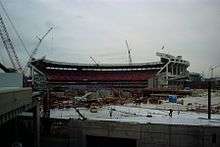
When the Bengals moved to Paul Brown Stadium in 2000, the Reds were left as Cinergy Field's only tenant. Prior to the 2001 baseball season, the stadium was remodeled into a baseball-only configuration, and the artificial surface was replaced with grass.

To allow room for the construction of Great American Ball Park (which was being built largely over the grounds the stadium already sat on), a large section of the left and center field stands were removed and the distance to the fences was shortened by 5 feet (1.5 m). A 40-foot (12 m) wall was built in deep center field to prevent easy home runs. The new Great American Ball Park and old Riverfront Stadium were 26 inches apart at its closest point during this time. In the Reds' final two seasons in the stadium, ongoing construction on Great American was plainly visible just beyond the outfield walls while the team played their games.
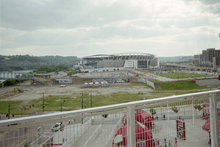
The stadium was demolished by implosion on December 29, 2002. Today, part of the site is now occupied by Great American Ball Park and the National Underground Railroad Freedom Center, along with several mixed-use developments and parking facilities. A small portion of the Riverfront Stadium site is now occupied by the Reds' Hall of Fame and Museum and Main Street, which was extended when the new park was built and when the old park was demolished.
Seating capacity
Attendance records
Bold indicates the winner of each game.
Baseball
| Highest Baseball attendance at Riverfront Stadium | ||||
| Rank | Attendance | Date | Game result | Notes |
|---|---|---|---|---|
| 1 | 56,393 | October 16, 1975 | Reds 6, Red Sox 2 | 1975 World Series, Game 5 |
| 2 | 56,079 | October 12, 1990 | Reds 2, Pirates 1 | 1990 NLCS, Game 6 |
| 3 | 56,040 | October 22, 1972 | Athletics 3, Reds 2 | 1972 World Series, Game 7 |
| 4 | 55,832 | October 17, 1990 | Reds 5, Athletics 4 (10) | 1990 World Series, Game 2 |
| 5 | 55,830 | October 16, 1990 | Reds 7, Athletics 0 | 1990 World Series, Game 1 |
Football
| Highest Football attendance at Riverfront Stadium | |||
| Rank | Attendance | Date | Game result |
|---|---|---|---|
| 1 | 60,284 | October 17, 1971 | Bengals 24, Browns 27 |
| 2 | 60,157 | December 20, 1970 | Bengals 45, Patriots 7 |
| 3 | 60,099 | October 10, 1970 | Bengals 13, Dolphins 23 |
| 4 | 60,084 | December 9, 1990 | Bengals 17, 49ers 20 |
| 5 | 60,067 | November 4, 1990 | Bengals 7, Saints 21 |
Milestones
Baseball
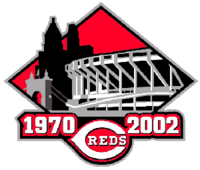
- First stadium to have its entire field covered by AstroTurf, except for the cutouts around the bases and pitcher's mound.
- First hit: Félix Millán, June 30, 1970.
- First home run: Hank Aaron, June 30, 1970.
- First Presidential Visit: Richard Nixon, July 14, 1970.
- First upper deck home run: Tony Pérez, August 11, 1970.
- First World Series game ever played on artificial turf: October 10, 1970 (Reds vs. Baltimore Orioles).
- First no-hitter: Ken Holtzman, June 3, 1971.
- First pitcher ever to pitch a no-hitter and hit two home runs in the same game: Rick Wise, June 23, 1971.
- Hank Aaron ties the all-time home run record with number 714: April 4, 1974.
- First stadium to display metric distances on the outfield walls (100.58 meters down the lines, 114.30 to the alleys, 123.13 to center): 1976.
- Highest season attendance, 2,629,708: 1976.
- First rain checks issued: August 30, 1978.
- First player to hit for the cycle: Mike Easler, June 12, 1980.
- Pete Rose breaks the all-time hit record with number 4,192: September 11, 1985.
- First player ever to be caught stealing four times in one game: Robby Thompson, June 27, 1986.
- Perfect Game: Tom Browning, September 16, 1988.
- Umpire John McSherry collapsed and died on April 1, 1996.
- Longest home run, 473': Mark McGwire, May 5, 2000.
Football
- First touchdown: Sam Wyche, September 20, 1970
- First Field goal: Horst Muhlmann, September 20, 1970
- Freezer Bowl: lowest wind-chill (2nd lowest temperature) in NFL history, January 10, 1982
- Steve Largent becomes the first player in NFL History to catch 100 TD's in career, December 10, 1989.
- Corey Dillon breaks the single-game rookie rushing record with 246 yards on December 4, 1997.
Concerts
| Date | Artist | Opening act(s) | Tour / Concert name | Attendance | Revenue | Notes |
|---|---|---|---|---|---|---|
| August 4, 1976 | Jethro Tull | — | Too Old To Rock 'N' Roll Tour | — | — | |
| August 16, 1978 | The Eagles | Eddie Money The Steve Miller Band | Hotel California Tour | 51,855 | — | |
| September 14, 1989 | The Rolling Stones | Living Colour | Steel Wheels Tour | 53,555 / 53,555 | $1,522,536 | |
| July 10, 1990 | New Kids on the Block | Perfect Gentlemen | The Magic Summer Tour | 48,000 / 48,000 | — | |
| May 5, 1993 | Paul McCartney | — | The New World Tour | 38,000 / 40,000 | $1,156,513 | [11] |
| August 30, 1994 | The Rolling Stones | Lenny Kravitz | Voodoo Lounge Tour | 34,137 / 55,000 | — | |
| May 21, 2000 | George Strait | Asleep at the Wheel Lee Ann Womack Mark Chesnutt Kenny Chesney Martina McBride | George Strait Country Music Festival | 42,000 | — | |
| July 14, 2000 | 'N Sync | Sisqo P!nk | No Strings Attached Tour | 48,234 / 48,234 | $2,091,097 | |
| June 6, 2001 | 'N Sync | Dream | Pop Odyssey Tour | 36,371 / 42,285 | $1,947,461 |
- The Kool Jazz Festival (now the Macy's Music Festival) was an annual fixture.
Religious gatherings
- The Jehovah's Witnesses hosted three conventions in the stadium, in 1971, 1974 and 1978.
- Promise Keepers held a meeting there in 1997.
Gallery
 Riverfront Stadium during a Cincinnati Reds game vs. the Chicago Cubs on May 23, 1988.
Riverfront Stadium during a Cincinnati Reds game vs. the Chicago Cubs on May 23, 1988. Riverfront Stadium in 1974
Riverfront Stadium in 1974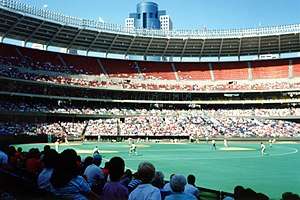 Riverfront Stadium in 1992
Riverfront Stadium in 1992 Cinergy Field during a Cincinnati Reds game vs. the New York Mets on April 27, 2001.
Cinergy Field during a Cincinnati Reds game vs. the New York Mets on April 27, 2001.
References
- Federal Reserve Bank of Minneapolis. "Consumer Price Index (estimate) 1800–". Retrieved January 1, 2020.
- "Cincinnati Riverfront Stadium". Architectural Record. Record and Guide. 147: 54. 1970.
- http://www.ballparksofbaseball.com/past/RiverfrontStadium.htm
- http://mlb.mlb.com/nym/ballpark/history.jsp
- http://www.steelersfever.com/three_rivers_stadium.html
- Flynn, Terry (October 2, 1983). "UC Lets Cornell Off with 48-20 Beating". The Cincinnati Enquirer. Cincinnati, Ohio. p. B-1 – via Newspapers.com.
- "2009 University of Cincinnati Football Media Guide" (PDF). gobearcats.com. Retrieved March 27, 2020.
- "Capsule Preview of NFL Games". Boston Globe. September 19, 1970.
- "Expect Good Game". Bryan Times. January 9, 1982.
- Paul McCartney Setlist Riverfront Stadium, Cincinnati, Ohio, USA on 5 May 1993
Sources
- Dittmar, Joseph J. (1997). Baseball Records Registry: The Best and Worst Single-Day Performances and the Stories Behind Them. McFarland & Company. ISBN 0-7864-0293-8
- Munsey & Suppes (1996–2004). Riverfront Stadium. Ballparks.
- Smith, Ron (2000). Riverfront Stadium. The Ballpark Book. The Sporting News. ISBN 0-89204-703-8
- Riverfront Stadium Opens. BaseballLibrary.com.
External links
| Wikimedia Commons has media related to Riverfront Stadium. |
- A Farewell to Cinergy Field. MLB.com.
- Cinergy Field: Kiss it Goodbye. Cincinnati.com.
- Riverfront Stadium/Cinergy Field. Ballparks of Baseball.
- Riverfront Stadium/Cinergy Field. Stadiums of Pro Football
- Cinergy Field. BaseballLibrary.com.
| Events and tenants | ||
|---|---|---|
| Preceded by Nippert Stadium |
Home of the Cincinnati Bengals 1970–1999 |
Succeeded by Paul Brown Stadium |
| Preceded by Crosley Field |
Home of the Cincinnati Reds 1970–2002 |
Succeeded by Great American Ball Park |
| Preceded by RFK Stadium Oakland–Alameda County Coliseum |
Host of the All-Star Game 1970 1988 |
Succeeded by Tiger Stadium Anaheim Stadium |
| Preceded by Jack Murphy Stadium Mile High Stadium |
Host of AFC Championship Game 1982 1989 |
Succeeded by Miami Orange Bowl Mile High Stadium |